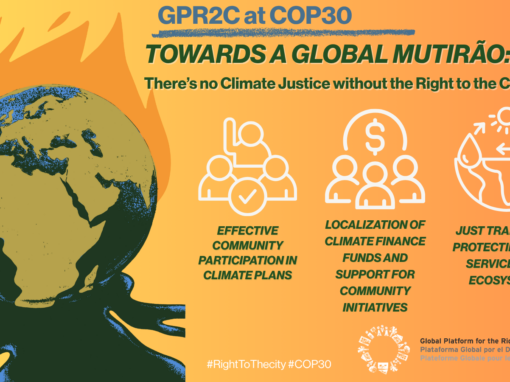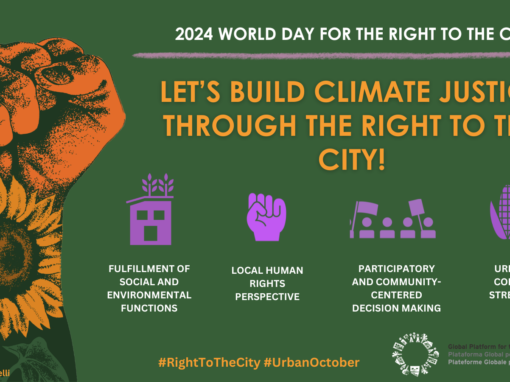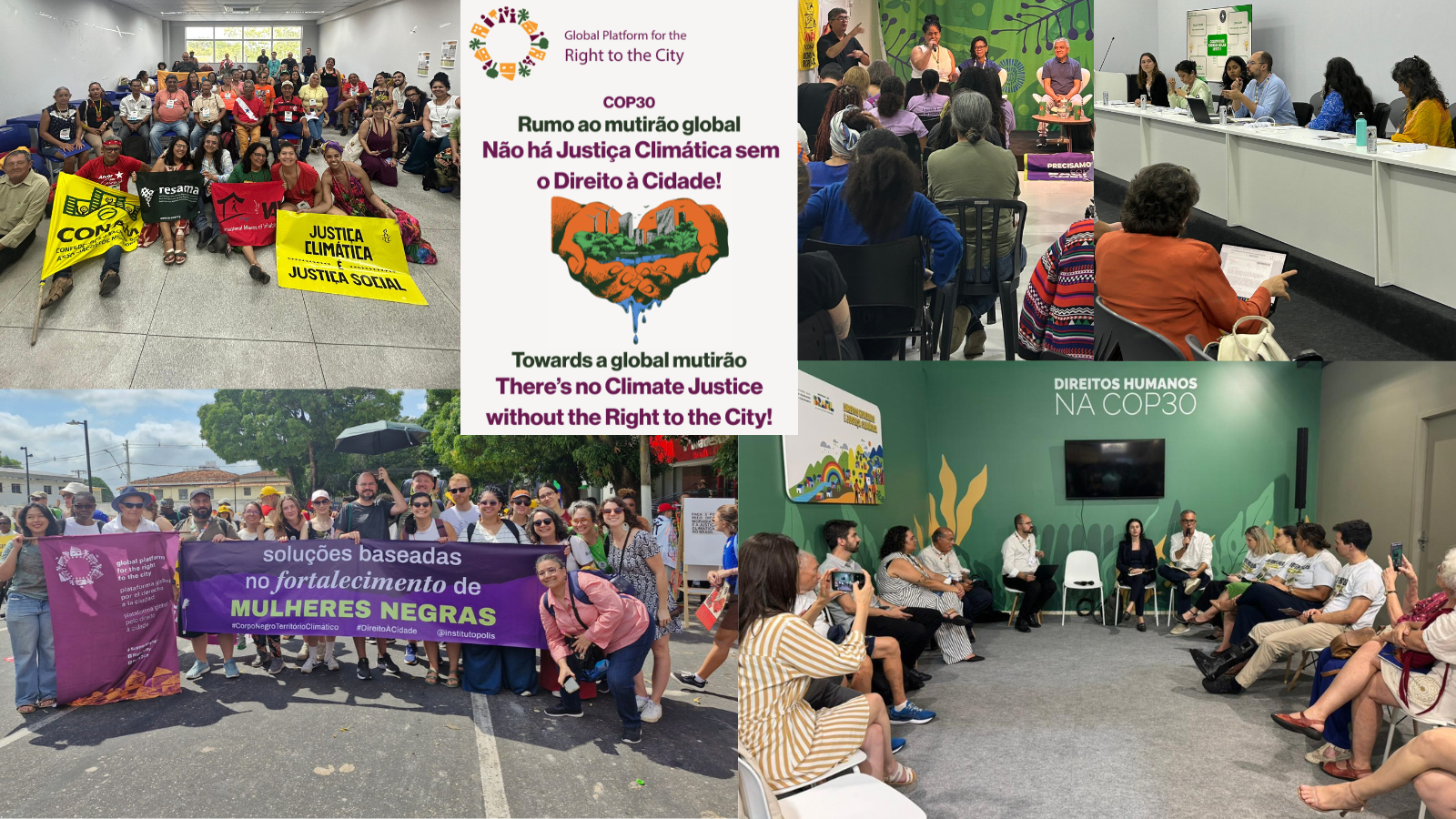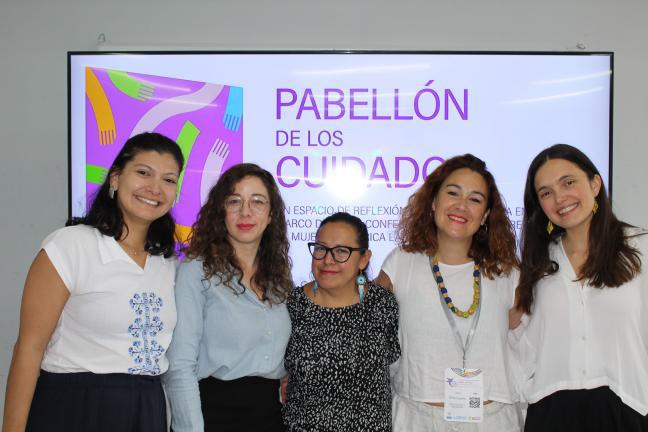The Global Platform for the Right to the City identified the elements of the Right to the City in the New Agenda Urban:
QUITO IMPLEMENTATION PLAN FOR THE NEW URBAN AGENDA
1 – Commitments: “States commit to promote/support, acknowledge, reaffirm”1
Subnational and local governments: stronger coordination for the provision of social and basic services and investments in vulnerable communities; housing policies among all tiers of government (31 and 32); their role in strengthening the interface among all relevant stakeholders, including different population and vulnerable groups, without discrimination (42); coordination with local authorities and stakeholders the rehabilitation and upgrading of slums and informal settlements (77); support local economic development; climate action (79).
Territorial development and urban-rural linkages: special attention in housing policies to the proximity factor and spatial relationship with the rest of the urban fabric and the surrounding functional areas (32); territorial systems that integrate urban and rural functions; sustainable management and use of natural resources and land in a way that considers urban-rural linkages; supply and value chains that connect urban and rural supply and demand (49); urban-rural interactions and connectivity (50); prioritizing urban renewal over urban sprawl and marginalization (52); water resources planning and management that considers the urban-rural continuum (72).
City as a common good, inclusion, equality, livelihoods and quality public spaces: Eradicate all forms and dimensions of poverty, including extreme poverty (25); spatial organization, accessibility, design of urban space, infrastructure and basic service provision (25); equally shared opportunities and benefits of urbanization to enable all inhabitants, whether living in formal or informal settlements (27); equitable, affordable and sustainable access to land, housing, modern and renewable energy, safe drinking water and sanitation, safe, nutritious and adequate food, waste disposal, sustainable mobility, healthcare and family planning, education, culture, and information and communication technologies (34); safe, inclusive, accessible, green and quality public spaces for social interaction and inclusion, human health and well-being and economic exchange (37); pluralism and peaceful co-existence (40); full and productive employment and decent work for all (43 and 57); social habitat production (46); access to income-earning opportunities, knowledge, skills and educational facilities (56); contribution of the working poor in the informal economy (59).
Housing: right to adequate housing for all; prevention of arbitrary forced evictions; focus on the needs of vulnerable persons and groups (31); age- and gender-responsive housing policies and approaches across all tiers of government and sectors, such as employment, education, healthcare, and social integration, for the provision of adequate, affordable, accessible, resource efficient, safe, resilient, well-connected, and well-located housing; with special attention to proximity and spatial relationship with the urban fabric (32); safe, affordable, and accessible for members of different income groups; consideration for socio-economic and cultural integration; prevention of segregation (33); security of tenure for all (35); role of affordable and sustainable housing and housing finance, including social habitat production, in economic development (46).
Mobility: sustainable and efficient transport infrastructure and services (54).
Sanitation, waste, water and health: healthy societies by promoting adequate, inclusive, and quality public services, a clean environment, air quality guidelines, social infrastructure and facilities (55); long-term urban and territorial planning that incorporate integrated water resources (72); rehabilitating water resources within the urban, peri-urban, and rural areas, reducing and treating waste water (73); environmentally sound waste management; substantially reduce waste generation (74).
Sustainability and climate change mitigation: sustained, inclusive, and sustainable economic growth (43); renewable and affordable energy (54); cities and human settlements face unprecedented threats from unsustainable consumption and production patterns, loss of biodiversity, pressure on ecosystems, pollution, and natural and man-made disasters, and climate change and its related risks. The way they are planned, financed, developed, built, governed, and managed has a direct impact on sustainability and resilience well beyond the urban boundaries (63); urban centers are especially vulnerable to climate change, natural and man-made hazards (64); sustainable management of natural resources that protects and improves urban ecosystem and environmental services, disaster risk reduction and management, and reducse greenhouse gas emissions and air pollution (65); quality public spaces for resilience (67); ecological and social function of land (69); [consider] urban-rural linkages and functional supply and value chains vis-à-vis environmental impact and sustainability (71); resilient and resource-efficient infrastructure to reduce the risks and the impact of disasters; rehabilitation and upgrading of slums and informal settlements and all the risky housing stock (77); proactive, risk-based, all-hazards and all-of-society approaches; timely and effective local responses to the immediate needs of inhabitants affected by disasters and conflicts (78); adaptation plans, policies, programmes, and actions that build resilience of urban inhabitants; ecosystem-based adaptation (80).
Women, vulnerable population groups and the disfranchised: end all forms of discrimination and violence; empowering all individuals and communities (26); respect human rights and humane treatment of refugees, internally displaces persons and migrants (28); focus of housing strategies on the needs of vulnerable persons and groups (31); age- and gender-responsive housing policies (32); housing options for different income groups to achieve socio-economic and cultural integration, preventing segregation (33); basic physical and social infrastructure responsive to the rights and needs of women, children and youth, older persons and persons with disabilities, migrants, indigenous peoples and local communities as appropriate, and others that are in vulnerable situations; eliminate legal, institutional, socio-economic, or physical barriers (34); age-, gender- and environment-responsive solutions within the continuum of land and property rights, security of land tenure for women (35); facilitated access for persons with disabilities in urban and rural areas (36); urban life without fear of violence and intimidation, in particular for women and girls, and children and youth, and persons in vulnerable situations (39); role of sub-national and local governments in stronger interface among relevant stakeholders, including age- and gender-responsive approaches; attention to potential contributions of men and women, children and youth, older persons and persons with disabilities, indigenous peoples and local communities, refugees and internally displaced persons and migrants, regardless of migration status, and without discrimination based on race, religion, ethnicity, or socio-economic status (42); effective participation of local governments, the private sector, civil society, and organizations for women and youth, persons with disabilities, indigenous peoples, professionals, academic institutions, trade unions, employers’ organizations, migrant associations, and cultural associations (48); recognize the working poor in the informal economy, particularly women, including the unpaid, domestic, and migrant workers to the urban economies (59); [address] the social, economic, and spatial implications of ageing populations (62); stronger resilience through integrated, age-and gender-responsive policies and plans and ecosystem-based approaches (77).
Participation: full and meaningful participation of all individuals and communities (26); leverage natural and cultural heritage to strengthen participation and citizenship (38); inclusive platforms for meaningful participation in decision-making, planning, and follow-up processes; enhanced civil engagement and co-provision and co-production (41); meaningful participation of girls and boys, young women and young men (61); participatory urban and territorial planning processes and spatial development (72); coordination with local authorities and stakeholders the rehabilitation and upgrading of slums and informal settlements (77).
Culture diversity and expressions: culture, diversity, and equality as key to humanization (26); cultural infrastructures for the revitalization of urban areas and stronger participation and citizenship (38); quality public spaces for cultural expression and dialogue (37); pluralism and peaceful co-existence (40).
2 – Effective implementation of the NUA: states “require, take measures, promote, support, implement, foster”
General: coherence between sectorial policies: rural development, land use, food security and nutrition, management of natural resources, provision of public services, water and sanitation, health, environment, energy, housing and mobility policies at different levels and scales of political administration (88).
Subnational and local governments: enabling policy framework at the national, subnational and local levels (81 and 86); stronger coordination and cooperation, including multi-level consultation mechanisms (87); capacity of sub-national and local governments to implement effective local and metropolitan multi-level inclusive governance, ensuring their involvement in decision-making (90); local governments’ own administrative and management structures; local governments partnership with communities, civil society, and the private sector to develop and manage basic services and infrastructure (91); build capacity of local authorities to develop and implement disaster risk reduction and response plans (101); training on urban planning and design at national, sub-national, and local levels (102); basic land inventory information by local governments and relevant stakeholders (104); subsidiarity in housing policies to ensure coherence (105); differentiated analysis of housing supply and demand based on disaggregated data at the national, sub-national, and local levels, considering specific social, economic, environmental, and cultural dimensions (111); national, sub-national and local transport and mobility infrastructure and systems (118); sub-national and local efforts to ensure universal access to affordable, reliable and modern energy services (121).
Territorial development and urban-rural linkages: integrated, polycentric, and balanced territorial development policies and plans, cooperation and support among different scales of cities and human settlements; strengthen the role of small and intermediate cities and towns in food security and nutrition systems; housing, infrastructure, services, effective trade links across the urban-rural continuum; ensuring that small-scale farmers and fishers are linked to local, sub-national, national, regional, and global value chains and markets; urban agriculture and farming, responsible, local, and sustainable consumption and production; social interactions through accessible networks of local markets and commerce to contribute to sustainability and food security (95); sustainable regional infrastructure projects that promote equitable growth of regions across the urban-rural continuum (96); [in the context of planned urban extensions] compactness, polycentrism, appropriate density and connectivity, multiple use of space, as well as mixed social and economic uses to prevent urban sprawl, to reduce mobility challenges and needs and service delivery costs per capita, and to harness density and economies of scale and agglomeration, as appropriate (98); integrate transport and mobility plans into overall urban and territorial plans, enhancing connectivity between urban, peri-urban, and rural areas (114); better coordination between transport and urban and territorial planning departments (117); sanitation infrastructure, housing, mobility, among others, as part of integrated urban and territorial development plans (119); sustainable food security and agriculture policies across urban, peri-urban, and rural areas to facilitate the production, storage, transport, and marketing of food to reduce food losses and to prevent and reuse food waste (123).
City as a common good, inclusion, equality, livelihoods and quality public spaces: upgrading of slums and informal settlements, providing high-quality buildings and public spaces, avoiding spatial and socio-economic segregation and gentrification, preserving cultural heritage and preventing and containing urban sprawl (97); social mix through the provision of affordable housing options with quality basic services and public spaces for all, safety and security, social and inter-generational interaction and the appreciation of diversity (99); well-designed networks of safe, inclusive for all inhabitants, accessible, green, and quality public spaces and streets, free from crime and violence, considering the human-scale, best possible commercial use of street-level floors, fostering local markets and commerce, both formal and informal, as well as not-for-profit community initiatives, bringing people into the public spaces, promoting walkability and cycling towards improving health and well-being (100); right to adequate housing as a component of the right to an adequate standard of living (105); use of public resources for affordable and sustainable housing, including land in central and consolidated areas, mixed-income development (106).
Housing: affordable, sustainable housing, rental, cooperative solutions, collective tenure and other options to improve the supply especially for low-income groups; incremental housing and self-build schemes; slums and informal settlements upgrading programmes; prevent segregation and arbitrary forced evictions and displacements and provide dignified and adequate re-allocation (107); integrated housing approaches: links between education, employment, housing, and health, preventing exclusion and segregation (108); upgrading and the prevention of slums and informal settlements for social, economic, cultural, and political integration (109); housing strategies that give access to sustainable, adequate, safe, and affordable housing, basic and social services, safe, inclusive, accessible, green, and quality public spaces; security of tenure and regularization, conflict prevention and mediation (109); reducing the proportion of people living in slums and informal settlements, to improve the living conditions (110); regulations to combat and prevent speculation, displacement, homelessness, and arbitrary forced evictions, ensuring sustainability, quality, affordability, health, safety, accessibility, energy and resource efficiency, and resilience; analysis of housing supply and demand based on disaggregated data that considers specific social, economic, environmental, and cultural dimensions (111); [avoid] peripheral and isolated mass housing developments detached from urban systems (112).
Mobility: improve road safety and integrate it into sustainable mobility and transport infrastructure planning and design; pedestrian safety and cycling mobility; motorcycle safety (113); safe, age- and gender-responsive, affordable, accessible, and sustainable urban mobility and land and sea transport; accessible safe, efficient, affordable, and sustainable infrastructure for public transport; equitable Transit-Oriented Development (TOD) that minimizes the displacement in particular of the poor and features affordable, mixed-income housing and a mix of jobs and services; reduction of travel and transport needs; urban freight planning and logistics concepts that minimize impact on the environment and the livability in the city; integrate transport and mobility plans into overall urban and territorial plans, promoting a wide range of options (114); mechanisms to evaluate the benefits of urban and metropolitan transport schemes, including impacts on the environment, the economy, social cohesion, quality of life, accessibility, road safety, public health, and action on climate change (115); better coordination between transport and urban and territorial planning departments (117); technology-based innovations to reduce congestion and pollution (118).
Sanitation, waste, water and health: protective, accessible, and sustainable infrastructure and service provision systems for water, sanitation, and hygiene, sewage, solid waste management, urban drainage, reduction of air pollution, and storm water management to improve safety against water-related disasters, health, and ensure universal and equitable access to safe and affordable drinking water for all; as well as access to adequate and equitable sanitation and hygiene for all; and end open defecation (119); water management systems and maintenance of urban infrastructure services, through capacity development to eliminate inequalities and promote universal and equitable access (120); decentralized decision-making on waste disposal to promote universal access (122); reduce the hazards and social economic impacts of waste streams; improved recycling rates through better product design (122).
Transparency: transparent and accountable finance mechanisms (86); inclusive, transparent and sustainable management frameworks and accountable institutions for land registration, use, governance, property registration, and financial system (104); transparent monitoring systems for reducing the proportion of people living in slums and informal settlements (110); transparent procurement, regulation and contractual relationships between local governments and transport and mobility services in urban and metropolitan areas (116).
Sustainability and climate change mitigation: sustainable regional infrastructure projects that stimulate sustainable economic productivity (96); planned urban extensions based on the principle of equitable, efficient, and sustainable use of land and natural resources (98); age and gender-responsive urban and territorial development and planning integrated with disaster risk reduction, and climate change adaptation; build capacity of local authorities to develop and implement disaster risk reduction and response plans (101); technology-based innovations to reduce congestion and pollution (118); climate-resilient sanitation infrastructure (119); universal access to affordable, reliable and modern energy services through energy efficiency and sustainable renewable energy (121).
Participation: effective implementation of the NUA requires a policy framework integrated by participatory planning (81 and 86); support to local governments in partnering with communities, civil society, and the private sector to develop and manage basic services and infrastructure (91); participatory age- and gender-responsive urban and territorial policy and planning processes, rooted in partnership between governments at all levels and civil society, permanent mechanisms and platforms for cooperation and consultation open to all, using information and communications technologies and accessible data solutions (92); integrated and participatory approaches in urban interventions such as slum upgrading (97); incorporating participatory planning in housing policies (105); participatory implementation of sanitation infrastructure (119).
Women, vulnerable population groups and the disfranchised: effective implementation based on the principles of equality and non-discrimination (89); women’s full and effective participation and equal rights in all fields and in leadership at all levels of decision-making, including in local governments (90); public spaces and streets free from sexual harassment and gender-based violence (100); age and gender-responsive urban and territorial development and planning integrated with disaster risk reduction, and climate change adaptation (101); inclusive measures of urban safety and crime and violence prevention policies that takes into account slums and informal settlements, vulnerability and cultural factors, preventing and countering stigmatization of specific groups (103); disaggregated data by income, sex, age, race, ethnicity, migration status, disability, geographic location, and other characteristics in the context of land inventory information systems, not to be used for discriminatory policies on land use (104); [combat] to homelessness and its criminalization (108); special attention to the needs of all women and girls, as well as children and youth, older persons and persons with disabilities, and those in vulnerable situations, in mobility and transport infrastructure (113); safe and healthy journey to school for every child as a priority (113); safe, age- and gender-responsive urban mobility, land and sea transport systems (114); special attention to the needs and safety of women and girls and those in vulnerable situations in sanitation and related public health services (119).
Culture diversity and expressions: preservation of cultural heritage in urban interventions (97); culture as a priority component of urban plans and strategies to safeguard a diverse range of tangible and intangible cultural heritage and landscapes, and protect them from potential disruptive impacts of urban development (124); leverage cultural heritage for sustainable urban development, participation and responsibility (125); engage indigenous peoples and local communities in the promotion of knowledge of tangible and intangible cultural heritage and protection of traditional expressions and languages (125).
3 – Means of implementation: will encourage, urge, provide, support, promote, and strengthen
Subnational and local governments: enabling environment and a wide range of means of implementation that taps into all available traditional and innovative sources and partnerships at the global, regional, national, sub-national, and local levels (126); evidence-based and practical guidance for the implementation of the NUA in collaboration with local authorities (128); normative knowledge and capacity development to national, subnational and local governments in designing, planning, and managing sustainable urban development (129); register and expand subnational and local governments’ revenue base (134); inequality reduction models among sub-national territories(136); implement transparent and accountable expenditure control instruments by national, subnational and local governments (138); involvement of local government associations in national consultations on urban policies and development priorities, cooperation with sub-national and local governments, along with civil society and other players, to deliver on capacity development programmes (149); capacity development programmes to sub-national and local governments in financial planning and management (151); strengthening data and statistical capacities at all levels (158); enhanced capacity of national, sub-national, and local governments in data collection, mapping, analysis, and dissemination, and promotion evidence-based governance (159).
Territorial development and urban-rural linkages: inequality reduction within urban centers and between urban and rural areas, as well as integrated and balanced territorial development (136).
City as a common good, inclusion, equality, livelihoods and quality public spaces: capture and share of the increase of value of urban property to prevent solely private capture and real estate speculation (137); capacity development programmes for policymakers and local public officials on the use of legal land-based revenue, financing tools, real estate market functioning, legal and economic foundations of value capture, including quantification, capturing, and distribution of land value increments (152).
Transparency: transparency in financial transfer system from national to sub-national and local governments (135); transparency as a tool to assess progress towards equity and spatial integration (136); sub-national and local governments implementation of transparent and accountable expenditure control instruments (138); capacity development programmes to sub-national and local governments including anti-corruption measures (151); data collection for the implementation, follow-up and review of the NUA should be open, transparent and consistent with privacy rights and human (158); transparency through e-governance, information and communications technologies assisted approaches, and geospatial information management (160).
Sustainability and climate change mitigation: generation of land-based finance should not result in unsustainable land use and consumption (137); collaboration with sub-national and local financial institutions to develop climate finance infrastructure solutions (143); solutions for climate and disaster risks in cities and human settlements (144); capacity development to sub-national and local governments including environmental sensitivity measures (151).
Participation: capacity of national, sub-national, local governments and local government associations to work with women and girls, children and youth, older persons and persons with disabilities, indigenous peoples and local communities, and those in vulnerable situations, civil society, the academia, and research institutions in shaping organizational and institutional governance processes, enabling them to effectively participate in urban and territorial development decision-making (148); empower certain disfranchised groups to ensure effective participation in urban and territorial development decision-making (155) through technological innovation, broadening participation and fostering responsible governance (156 and 160); open, user-friendly and participatory data platforms using technological and social tools to transfer and share knowledge among all tiers of government and non-state actors and people (160).
Women, vulnerable population groups and the disfranchised: women and girls, children and youth, older persons, persons with disabilities, indigenous peoples and local communities, and poor households should not be disproportionately affected by the increase of the revenue base of local and sub-national governments (134); age and gender-responsive budgeting in capacity development programmes to help sub-national and local governments (151); capacity development initiatives to empower women and girls, children and youth, older persons and persons with disabilities, indigenous peoples and local communities, as well as persons in vulnerable situations for their effective participation in urban and territorial development decision-making (155); development of technological innovation to ensure development, exercise of civic responsibility, broader participation, fostering responsible governance for women and girls, children and youth, persons with disabilities, older persons and persons in vulnerable situations (156); locally generated data, including community-based monitoring processes, disaggregated by income, sex, age, race, ethnicity, migration status, disability, geographic location, etc relevant in national, sub-national, and local contexts (159).
4 – Follow-up and review of the NUA
General: periodic follow-up and reviews to ensure coherence at national, regional and global levels, to track progress, assess impact, and ensure effective and timely implementation, accountability to our citizens, and transparency, in an inclusive manner (161); take into account contributions of national, sub-national and local levels of government (162); local governments are important and encouraged to engage with national and sub-national governments to develop implementable follow-up and review mechanisms at the local level (163); four-year report to the General Assembly should incorporate inputs from civil society (167); new implementation initiatives should be considered to mobilise and generate support from civil society, citizens and relevant stakeholders (169); importance of local and subnational and local government associations represented at the World Assembly of Local and Regional Governments (169).





